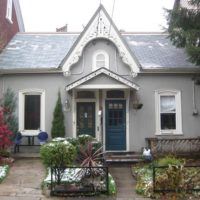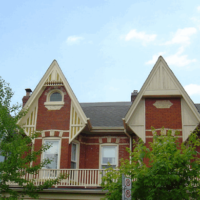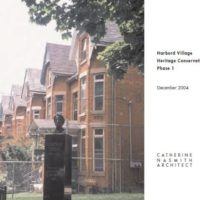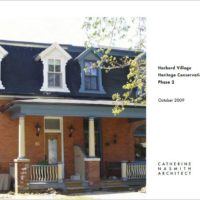AIMS | GRANTS | HCD APPLICATIONS | HANDBOOK | HISTORIC WALKS
Harbord Village was built mainly in the 1880s and 1890s, the era that enthusiastically embraced Toronto’s defining “Bay-n-Gable” housing style. Homeowners on two blocks of Harbord Village with a total of 349 houses have been granted Heritage Conservation designation (HCD) to help maintain the area’s dignity and harmony.
- Read about heritage conservation grants and tax rebates from the City for houses with Heritage designations.
- Browse our three impressive HCD applications. They show the defining architectural qualities of houses in the area.
- See also links for two relevant handbooks: one with practical advice about conserving and renewing heritage properties, and another about historic walks to help you explore the area.
Aims of a Heritage Conservation District
- To prevent demolition of the homes that define a community’s character
- To encourage conservation of the community’s historic character
- To encourage restoration rather than renovation when home exteriors need new roofs, doors, windows, porches, garden fences or re-painting.
HCD guidelines do not apply to the sides or backs of houses or to their interiors—unless their owners want them to.
Heritage Conservation Grants
The city provides support for owners of heritage properties in Heritage Conservation Districts. Each year, it offers grants for up to 50% of the estimated cost of heritage conservation work on eligible houses. (Heritage properties that pay commercial taxes are also eligible for tax rebates.)
If you own a Harbord Village house that has been designated under our previous applications (described below), you can apply to the Toronto Heritage Grant Program for work to repairs and retain defining heritage attributes like masonry, windows, doors, wood detailing and slate roofs. More information on eligibility and procedures is available at the Heritage Grant Program website.
Harbord Village Heritage Applications
HVRA’s two successful applications indicate the characteristics used to define heritage value. The District Plans based on these applications make good reading and viewing. Click on the green text below to open the PDF files for Phase I and Phase II plans.
Our HCD Application for Phase III was received in June 2013 by the Heritage Preservation Board, but has not yet reached the top of the list for consideration. This 25-page document, prepared mainly by Leslie Thompson, is informative, readable, and interesting for its insights into Harbord Village history. It analyses the range of Harbord Village housing styles, names some of the original builders, describes our laneways, and summarizes population flow into and out of the area. It also includes many more photos like the one above, which shows the rhythm of a distinctive Toronto Bay-n-Gable row of houses at 79-85 Lippincott.
In January 2018, Leslie Thompson had five minutes to speak to the City’s Planning and Growth Management Committee. Noting the long delay in considering our application, she made a strong case for interim protection of houses in our area. Here are the PowerPoint slides from her talk (a PDF file).
Handbook of Heritage Advice and Resources
Thanks to the generosity of local resident Richard Longley, HVRA can make available on this website, free of charge, an extensive and regularly updated Handbook and Directory of advice and resources for those engaged in Heritage Conservation activities of all kinds. (See below about buying a print copy.) This 72-page handbook covers the following points:
- What it means to live in a Heritage Conservation District and how HCDs are formed
- How HCDs are monitored: the HVHCD Advisory Committee, Heritage Preservation Services and Heritage Permits
- What the “elements” (doors, window, pillars, railings etc.) that have been significantly altered or completely removed from the facades of our properties originally looked like
- Conservation and restoration consultants, contractors and craftspeople who are qualified to help us conserve and restore the heritage character of our properties
- Suppliers of the materials and reproduced elements needed to make restoration possible: such items as roofing slate, heritage paint colours, brick, masonry and woodwork.
Historic Walks in Harbord Village
Historic Walks in Harbord Village is a free street-by-street guide to our neighbourhood. It includes introductory pages by Margaret Procter and Wendy Smith about pre-settlement history and Indigenous presence in the area, and about the 1793 creation of Park Lots by Governor Simcoe. The main portion offers information on the origin of all street names, notes on local architecture, and identification of properties which had notable residents in the past. Richard Longley has kindly made this PDF file available free of charge on this website. (See below about buying a print copy.)
Richard notes:
This guide could not have been compiled without the help of the researchers of the Harbord Village Laneway Project, members of the Harbord Village History Group and other local historians. They include in particular two who contributed to the introduction: Margaret Procter sketched the very early history of the area and its Indigenous populations, and Wendy Smith provided the information about Park Lots. She also found the origins of some hitherto unexplained street names (Harbord Street, notably).
This is a work in progress. Like all histories it can never be complete, but to help move it closer to that elusive goal, all corrections and contributions will be welcome which describe the history of Harbord Village from pre-contact times to the present, as will historic maps, photographs and other illustrations (to help produce an illustrated version in future). Please send your comments and contributions to Richard Longley, longley_fovea@sympatico.ca, 68 Brunswick Avenue.
NOTE: Printed versions of either handbook may be purchased from Richard Longley (contact information above) for a small fee. Any proceeds from sales go to the HVRA.





